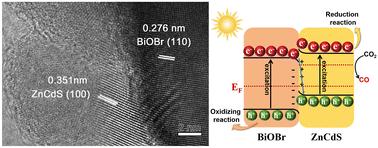Enhanced photocatalytic degradation and CO2 reduction activity of S-type ZnCdS/BiOBr heterojunction composites: mechanism insights and pathway analysis
IF 2.9
3区 化学
Q3 CHEMISTRY, PHYSICAL
引用次数: 0
Abstract
S-type ZnCdS/BiOBr heterojunction photocatalysts were successfully created by the attachment of ZnCdS nanoparticles on the surface of BiOBr nanosheets. Upon simulated sunlight irradiation, the photocatalytic activity of ZnCdS/BiOBr composites for the removal of dyes (methyl orange (MO) and methylene blue (MB)) and an antibiotic (tetracycline (TC)) was systematically investigated. The findings suggested that the photodegradation performance of BiOBr was apparently improved after decoration with ZnCdS nanoparticles. The 4% ZnCdS/BiOBr sample manifested an optimal photocatalytic degradation activity, and compared with bare BiOBr, its removal rates for MB, MO and TC were improved by ∼2.8, ∼4.6 and ∼2.9 times, respectively. The probable degradation pathway of TC was studied in detail. On the other hand, the photocatalytic CO2 reduction activity of the products was concurrently tested via excitation by simulated sunlight. The ZnCdS/BiOBr composites exhibited an enhanced catalytic performance for the reduction of CO2 into CO compared with BiOBr. Among them, the 4% ZnCdS/BiOBr sample had the best CO yield rate of 2.61 μmol g−1 h−1 (4 h reaction), which is ∼1.68 times higher than that of bare BiOBr. The possible photocatalytic CO2 reduction pathway was also predicted. The potential photocatalytic mechanism of the S-type ZnCdS/BiOBr heterojunction was proposed.

s型ZnCdS/BiOBr异质结复合材料增强光催化降解和CO2还原活性:机理和途径分析
通过在BiOBr纳米片表面附着ZnCdS纳米粒子,成功制备了s型ZnCdS/BiOBr异质结光催化剂。在模拟阳光照射下,系统研究了ZnCdS/BiOBr复合材料对染料(甲基橙(MO)和亚甲基蓝(MB))和抗生素(四环素(TC))的光催化活性。结果表明,纳米ZnCdS修饰后,BiOBr的光降解性能明显提高。4% ZnCdS/BiOBr样品表现出最佳的光催化降解活性,与裸BiOBr相比,其对MB、MO和TC的去除率分别提高了~ 2.8倍、~ 4.6倍和~ 2.9倍。详细研究了TC的可能降解途径。另一方面,通过模拟阳光激发,同时测试了产物的光催化CO2还原活性。与BiOBr相比,ZnCdS/BiOBr复合材料在将CO2还原为CO方面表现出更强的催化性能。其中,4% ZnCdS/BiOBr样品的CO产率最高,为2.61 μmol g−1 h−1(反应4 h),是裸BiOBr的约1.68倍。并对可能的光催化CO2还原途径进行了预测。提出了s型ZnCdS/BiOBr异质结的潜在光催化机理。
本文章由计算机程序翻译,如有差异,请以英文原文为准。
求助全文
约1分钟内获得全文
求助全文
来源期刊

Physical Chemistry Chemical Physics
化学-物理:原子、分子和化学物理
CiteScore
5.50
自引率
9.10%
发文量
2675
审稿时长
2.0 months
期刊介绍:
Physical Chemistry Chemical Physics (PCCP) is an international journal co-owned by 19 physical chemistry and physics societies from around the world. This journal publishes original, cutting-edge research in physical chemistry, chemical physics and biophysical chemistry. To be suitable for publication in PCCP, articles must include significant innovation and/or insight into physical chemistry; this is the most important criterion that reviewers and Editors will judge against when evaluating submissions.
The journal has a broad scope and welcomes contributions spanning experiment, theory, computation and data science. Topical coverage includes spectroscopy, dynamics, kinetics, statistical mechanics, thermodynamics, electrochemistry, catalysis, surface science, quantum mechanics, quantum computing and machine learning. Interdisciplinary research areas such as polymers and soft matter, materials, nanoscience, energy, surfaces/interfaces, and biophysical chemistry are welcomed if they demonstrate significant innovation and/or insight into physical chemistry. Joined experimental/theoretical studies are particularly appreciated when complementary and based on up-to-date approaches.
 求助内容:
求助内容: 应助结果提醒方式:
应助结果提醒方式:


